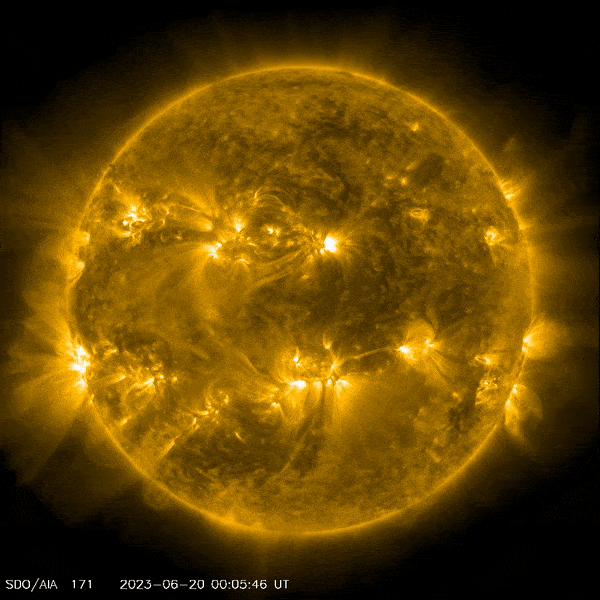On June 20, 2023, the Sun fired a powerful solar flare, which was captured by NASA’s Solar Dynamics Observatory. Credit: NASA/SDO
On June 20, 2023 at 1:09 PM ({” attribute=””>EDT) the Sun emitted a powerful solar flare. NASA’s Solar Dynamics Observatory, which watches the Sun continuously, captured an image of the event.
A solar flare is a sudden, significant increase in brightness seen near the Sun’s surface, particularly around sunspot groups. They are violent bursts of high-energy particles and gases ejected from the Sun’s magnetic field into space. Solar flares release a lot of energy, from ten million hydrogen bombs to a billion hydrogen bombs.
This flare is classified as an X1.0 flare. X-class means the most intense flares, while the number provides more information about its strength.

NASA’s Solar Dynamics Observatory captured this image of a solar flare — as seen in the bright flash at lower left — on June 20, 2023. The image shows a subset of UV light that highlights the hottest material in the flares and is colored yellow. Credit: NASA/SDO
How Solar Flares Are Measured
Solar flares are measured by the intensity of their X-rays around Earth. National Oceanic and Atmospheric Administration (NOAA) classifies solar flares into three categories:
- X-Class Flares: These are large; They are major events that can trigger planet-wide radio blackouts and long-lasting radiation storms.
- M-Class Flares: These are medium sized; They can cause brief radio blackouts affecting Earth’s polar regions. Minor radiation storms sometimes follow M-class flares.
- C-class flares: These are small, with few significant effects on Earth.
Each class is magnified by ten times the last, so X is magnified ten times that of M and 100 times that of C.
Effects of Solar Flares on Earth
Solar flares can have a wide range of effects on Earth. Here are some:
- Interruption of radio communication: When solar flares interact with Earth’s atmosphere, they can disrupt Earth’s magnetic field, causing radio and GPS signal, causing blackouts and navigation problems.
- Geomagnetic Storms and Auroras: If a solar flare is accompanied by a coronal mass ejection (CME), the solar wind and a massive burst of magnetic fields can cause geomagnetic storms. These storms can cause currents in the power grid, causing power outages. However, they can also produce stunning auroras (northern and southern lights).
- Radiation Hazard: Solar flares produce high levels of radiation that can pose a threat to astronauts in space or passengers on high-altitude flights. They are also of concern to electronic systems on satellites and spacecraft.
- Effects on Satellites: High-energy particles from solar flares can damage satellites, causing malfunction or data loss.
It is important to note that Earth’s magnetic field and atmosphere protect humans on the ground from the harmful effects of solar flares; The greatest concern is for space-borne technology and astronauts. However, in the event of a particularly strong solar flare, the consequences can be more severe. That is why space weather observatories closely monitor solar activity.

An artist’s concept of the Solar Dynamics Observatory (SDO). Credit: NASA/Goddard Space Flight Center Conceptual Image Lab
NASA’s Solar Dynamics Observatory
NASA’s Solar Dynamics Observatory (SDO), launched in February 2010, is a mission dedicated to studying the Sun. It is designed to help understand the influence of the Sun on Earth and near-Earth space, and the solar atmosphere by studying it at smaller scales of space and time and at multiple wavelengths simultaneously.
The primary objectives of SDO are:
- Solar Internal Dynamics: To understand the solar interior and how the Sun’s magnetic field is formed and structured. It uses helioseismology, the study of oscillations in the Sun, to map the interior of the Sun.
- Magnetic Field: To understand how the Sun’s magnetic field is released into the heliosphere (the space around the Sun) and into space in the form of the solar wind, energetic particles and variations in solar radiation.
- Solar Energy Release: Understanding the sources of solar variability that affect life and society by studying how magnetic energy is converted into kinetic energy of the solar wind, radiant energy of light and heat, and magnetic energy in solar flares and mass eruptions.
SDO includes a set of tools:
- Helioseismic and Magnetic Imager (HMI): It studies the oscillations and magnetic fields on the solar surface or photosphere.
- Atmospheric Imaging Assembly (AIA): It images the solar atmosphere at multiple wavelengths to link surface changes to interior changes. Its data includes images of the Sun at 10 wavelengths every 10 seconds.
- Extreme Ultraviolet Variability Experiment (EVE): It measures the sun’s ultraviolet brightness, an important energy source that affects Earth’s atmosphere and climate.
SDO is a mission in NASA’s Living With a Star (LWS) program, which aims to understand aspects of the Sun and Earth’s space environment that affect life and society. SDO data, continuously streaming to Earth in near-real time, has changed our understanding of the Sun and its impact on our planet.











